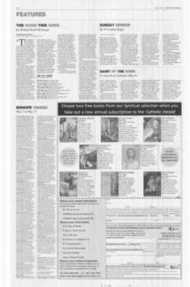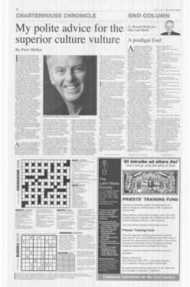Page 8, 5th May 2006
Page 8

Report an error
Noticed an error on this page?If you've noticed an error in this article please click here to report it.
Tags
Share
Related articles
Martyrs Remembered At Tower Service A Historic Service...
Jesuits Remember Tower Victims
A Gunpowder Plot Lie Is Killed
The Plot That Never Was
Bishop Recalls Sacrifice Of Martyrs
These were martyrs, not terrorists
A service in the Tower of London this week will commemorate the lives and deaths of four Jesuits who were executed for their part in the Gunpowder Plot. But these men were innocent of any crime and were simply loyal servants of the Church, says Anthony Symondson SJ Tomorrow evening the British Province of the Society of Jesus is holding a service in the Chapel Royal of St Peter ad Vincula in the Tower of London to commemorate the 400th anniversary of the deaths of Blessed Robert Ashley, Fr Henry Garnet, Blessed Edward Oldcorne and St Nicholas Owen for their part in the Gunpowder Plot.
It suited Robert Cecil. first Earl of Salisbury, to think
that they were the authors of
the pica and he was determined to involve Henry Garnet, the English Jesuit Superior, in a conspiracy against the Crown. Garnet was examined 23 times concerning his knowledge of the plot before an indictment could be found. "But if anything is determined against me individually," he wrote to Claudio Aquaviva, the Jesuit General, "it will come entirely from the fury and hatred that the heretics have against the Church. In that event I must, whatever happens, stand my ground and breast the unbroken strength of these storms with all my constancy."
Garnet feared that, in their undying hatred, the enemies of the Church should demand that Jesuits be treated more severely than the rest of the Catholic body. His fears were not misplaced.The Gunpowder Plot still inspires powerful emotions and in recent times has assumed new interest because some identify the plotters as precursors of modern terrorists acting in the name of religion. The Jesuits have been seen in the role of inflammatory mullahs directing and aiding the plotters in their deadly resolve.
This is altogether wrong. The reality is that they were innocent, minor players on the borders of a conspiracy. They were drawn into the vortex of the plot through their fidelity to the seal of the confessional, and their presence in the south Midlands, the main scene of the plotters' scheme.
On January 19,1606 the English government made an important capture connected with the Gunpowder Plot. Garnet, Oldcorne and the two Jesuit lay-brothers were taken in the hiding-place at Hindlip Hall, Thomas Habington's house five miles from Worcester, which had long been one of the centres for the work of the Jesuits in
the Midlands. Garnet was the man most closely in touch with Robert Catesby and his friends. It was suspected that he was in Worcestershire at Hindlip and a thorough search was made. After three days Nicholas Owen and Ralph Ashley came out for want of food; they had nothing but one apple between them to eat. Perhaps they thought their surrender might end the occupation of the house. but it did not, and on the eighth day Garnet and
Oldeorne emerged from the
hole in a chimney-breast where they had been unable to stand upright, and with no means of sanitation.
Garnet left a vivid description of the six days of close confinement in the hidingplace, the cramped conditions made worse by the books and furniture hidden with them, the swollen legs, continual pain and the lack of ventilation. Within four months Oldcome and Ashley were to die as martyrs at Worcester on April 7, Owen died on the rack in the Tower of London, Garnet was executed in St Paul's churchyard on May 3.
The Tower was the only prison in which torture could safely be used, for in all others people came and went with some freedom. In February 1606 leave was given to torture inferior prisoners "but if they put them in manacles then cause them to be kept still in the Tower".
This opened the way for the torture of the lay-brothers. What they wanted from these prisoners was proof that priests had approved of the conspiracy. That some did know of it was certain; but only under the seal of the confessional. The captives were taken to London; after being tortured for five hours together on five consecutive days, Oldcome was sent to Worcester with Ashley and hanged, drawn and quartered.
Owen, the constructor of hiding places, suffered greatly. He was mercilessly racked, although legally exempt from this torture owing to a rupture. As he constantly refused to give information about the whereabouts of priests, he was again racked until, on February 2, he died in agony after his vital parts had burst out under torture.
To cover their crime, the Council declared that he had taken his own life. But Owen's warder betrayed the
truth: "The man is dead; he died in our hands."
Garnet was at first welltreated in the Tower; he was a man of good birth and high reputation. There was no evidence that he had countenanced the plot; in fact he had written to Rome asking for a formal condemnation of all such schemes.
He was allowed to communicate with Anne Vaux and other friends; like many Catholics he used orange juice as invisible ink. These letters were read and copied by the authorities and still exist; they could not be used against Garnet, for they would have been evidence in his favour. Salisbury tried to
spread a rumour that. Garnet had admitted his complicity. Yet in a letter to the Earl of Mar he wrote that although "Whalley" (a code name for the Jesuit) had sworn that he had tried to dissuade the plotters, he would be executed as a traitor, for "it is expedient to make it manifest to the world how far these men's doctrinal practice reacheth into the bowels of treason, and so for ever stop the mouths of their calumniations that preach and print our laws to be executed for difference in point of conscience".
Garnet was tortured only once, and after trial was executed on May 3. King James gave orders that he should be allowed to hang until he died, and the dismemberment of his body caused pain only to those who looked on at the loathsome proceeding. The secretary of the Spanish ambas sador reported that when the executioner showed the head and bade "God save the King", there was not one "who would bestow an 'Amen', but instead thereof fell upon the hangman".
One Catholic spectator secured a straw from the basket into which Garnet's head was thrown. It was believed that the priest's likeness appeared on the bloodstained blade which was treasured as a relic; and the story of the martyr was added to the legends repeated by recusants throughout the years to come.
Altogether four Jesuit priests were connected with the plotters; no evidence worth considering implicated the lay-brothers. The other two were Fr John Gerard, a resourceful priest of great common sense, a born resistance leader, and Fr Oswald Tesimond, a big, noisy man, a hearty and not clever Jesuit, jovial and simple. Gerard left the country the very hour that Garnet died, wearing the livery of the Spanish ambassador; Tesimond knocked out his captor and escaped to the continent, hiding in a boat carrying a cargo of dead pigs. They were as innocent of complicity as Garnet and Oldcome.
What did these brave men die for? The first cause was the unity of the Church embodied in the papacy. Fidelity to the Pope is integral to the unity of the Church. The Church of England was a schismatic body that had abandoned the primacy of the papal office for the royal supremacy and was therefore in error. The recusant priests keptCatholics within the fold of the Church.
The second was the Mass. They died because it was Christ's sacrifice for the living and the dead, and the consecrated Host was the flesh of Christ, truths denied by Protestants. Without priests there were no sacraments, not just the Mass but the rest, with the exception of baptism and marriage. The Jesuits and other priests and religious were fearless in keeping the recusant body together. The gunpowder plotters were not martyrs, but acted against the authority of the Church and the law of the realm. The four Jesuits were.
A martyr is one who bears supreme witness to the truth of the faith even unto death. The martyr bears witness to Christ and to the truth and faith of Christian doctrine. He endures death through an act of fortitude. "Let me become the food of beasts," declared St Ignatius of Antioch, "through whom it will be given me to reach God."
After the Jesuits died people collected their relics. At Stonyhurst, Blessed Edward Oldcome's eye is keptin a silver reliquary formed as an eye socket. It took 16 days for his intestines to burn, one for every year he had worked in England, and on the site of the fire the grass took the form of an imperial crown.
Many sought Henry Garnet's relics on the scaffold; one man acquired his shirt, others different parts of his apparel, "which are now esteemed of more than their weight in gold".
The martyrs' fidelity has strong resonance for the present day. Our times are different from theirs, but in a period of apathy, listlessness, apostasy, and indifference their resolution is an inspiration, and the truth for which they died is eternal.
If you find being Catholic hard-going seek their prayers; they are powerful intercessors, and will help to give us backbone.
blog comments powered by Disqus

















